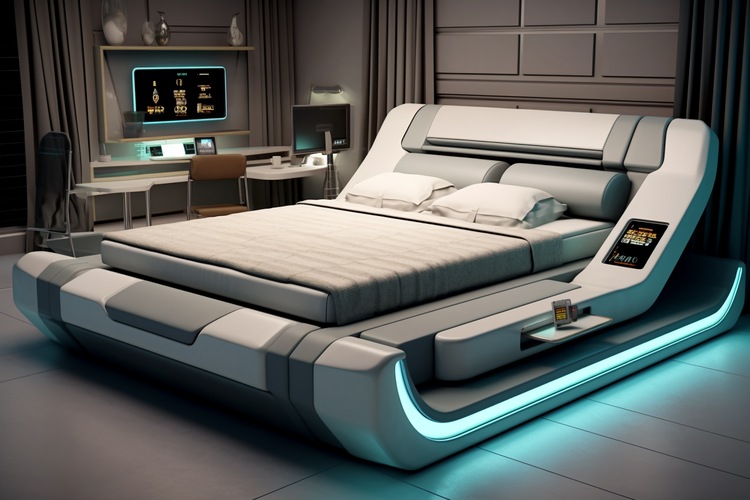Illuminating Interiors: The Art of Holographic Decor
In a world where technology and design intertwine, holographic decor emerges as a captivating frontier in home styling. This cutting-edge trend marries the ethereal with the tangible, transforming living spaces into mesmerizing realms of light and illusion. Imagine walking into a room where shimmering images dance on walls, furniture seems to float, and everyday objects take on an otherworldly glow. Welcome to the future of interior design, where holography redefines the boundaries of home aesthetics.

The Genesis of Holographic Home Design
Holography, once confined to the realms of science fiction and high-tech laboratories, has found its way into our homes, revolutionizing the concept of interior design. The journey from rudimentary holograms to sophisticated home decor elements spans decades of technological advancement and artistic vision.
In the 1960s, scientists first developed the ability to create three-dimensional images using laser technology. These early holograms were primarily used in scientific and industrial applications, far removed from the world of interior design. However, as the technology evolved, artists and designers began to see its potential for creating unique visual experiences.
The turn of the millennium marked a significant shift, as digital technology made holographic projections more accessible and versatile. Early adopters in the design world began experimenting with holographic displays in commercial spaces, slowly paving the way for its integration into residential interiors.
The Spectrum of Holographic Decor
Today’s holographic home decor offerings span a wide range of products and applications, each bringing a unique touch of futuristic elegance to living spaces. From subtle accent pieces to statement installations, holographic elements can be tailored to suit various design preferences and home styles.
Holographic wallpapers have emerged as a popular choice for those looking to make a bold statement. These dynamic wall coverings can transform a room’s appearance with the touch of a button, shifting from serene nature scenes to abstract patterns or even personalized designs. The ability to change the ambiance of a space without physical renovation has made holographic wallpapers a hit among urban dwellers and design enthusiasts alike.
Furniture with holographic elements is another exciting development in this field. Coffee tables that project 3D images, chairs that seem to change color as you move around them, and mirrors that display information while maintaining their reflective properties are just a few examples of how holography is being integrated into everyday furnishings.
The Technology Behind the Magic
The magic of holographic decor lies in its sophisticated technology. Modern holographic displays use a combination of advanced projection techniques, specialized materials, and smart controls to create their mesmerizing effects.
One key technology is the development of transparent OLED screens. These ultra-thin, see-through displays can be integrated into windows, mirrors, or glass partitions, allowing for holographic overlays on existing surfaces. When not in use, they remain completely transparent, preserving the original look of the space.
Another crucial advancement is in projection mapping technology. High-resolution projectors, coupled with sophisticated software, can now create precise, dynamic images on three-dimensional surfaces. This allows for the transformation of any object or space into a canvas for holographic art.
Practical Applications and Benefits
Beyond its aesthetic appeal, holographic decor offers practical benefits that are driving its adoption in modern homes. One of the most significant advantages is the ability to maximize space utilization. In small urban apartments, holographic elements can create the illusion of larger, more open spaces or even add virtual windows to windowless rooms.
Energy efficiency is another noteworthy benefit. Holographic lighting solutions can provide ambient illumination with minimal power consumption, contributing to lower energy bills and reduced environmental impact. Additionally, the versatility of holographic decor means that homeowners can change their interior design frequently without the need for physical redecorating, reducing waste and resource consumption.
Challenges and Considerations
While holographic decor offers exciting possibilities, it’s not without its challenges. The initial cost of installation can be significant, putting it out of reach for many consumers. There are also concerns about the long-term durability and maintenance of holographic systems, as the technology is still relatively new in the home setting.
Privacy is another important consideration. As holographic systems become more integrated with smart home technology, ensuring the security of personal data and preventing unauthorized access to holographic controls becomes crucial.
The Future of Holographic Home Design
As technology continues to advance, the future of holographic decor looks increasingly bright. Researchers are working on developing more sophisticated holographic displays that can create tactile sensations, allowing users to not just see but also feel holographic objects.
The integration of artificial intelligence is expected to take holographic decor to new heights. AI-powered systems could learn user preferences and automatically adjust holographic environments to suit moods, times of day, or specific activities.
Embracing the Holographic Revolution
Holographic decor represents a paradigm shift in how we think about and interact with our living spaces. It offers a unique blend of aesthetics, functionality, and technological innovation that is reshaping the landscape of interior design.
As this technology becomes more accessible and refined, we can expect to see holographic elements becoming increasingly common in homes around the world. From subtle accents to full-scale immersive environments, holographic decor is opening up new dimensions of creativity and personalization in home styling.
The journey from static, physical decor to dynamic, holographic environments is just beginning. As we stand on the brink of this exciting new era in interior design, one thing is clear: the homes of the future will be limited only by our imagination, with holographic technology serving as the canvas for our wildest design dreams.





